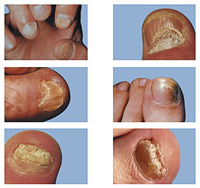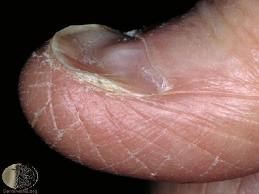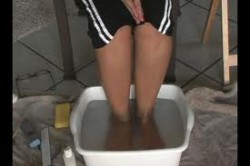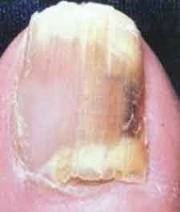Archive for the ‘Toenail Fungus Treatment’ Category
Onychomycosis
Onychomycosis
 Onychomycosis is a broad term for many different kinds of fungal infection. Our nails are necessary parts of our body and protect the sensitive tissue beneath them from harm. Onychomycosis makes our nails look bad and become brittle with development of the disease. Treatment can be long and difficult but ultimately effective.
Onychomycosis is a broad term for many different kinds of fungal infection. Our nails are necessary parts of our body and protect the sensitive tissue beneath them from harm. Onychomycosis makes our nails look bad and become brittle with development of the disease. Treatment can be long and difficult but ultimately effective.
Symptoms
- The nail begins to discolor, usually to opaque white or yellow
- This usually begins at the tip of the nail and works its way down
- The nail begins to thicken and become unattractive
- As the nail thickens, it can develop darker yellow and brown spots
- The nail becomes brittle and begins to crumble or flake off
- Ultimately the nail may pull away from the nail bed and partially or entirely fall off.
- These symptoms cause people embarrassment in public because of the appearance of their nails
- Their ability to walk or feel things may be hampered by pain or discomfort because of the disease
Causes and potential hazards
Onychomycosis is an infection that anyone and everyone can contract. It is seen most commonly as people age and it affects far more of the elderly population than the younger population, beginning around 40. Seeing it in kids is fairly rare, while people who are towards the end of life seem to suffer from it frequently. These people also tend to suffer from diseases that assist the fungus growth, like diabetes and poor circulation.
The easiest way to reduce the possibility of contracting a nail fungus infection is to take good care of your nails. The healthier they are, the easier it is for them to resist infection.
Treating and Healing From this Disease
The hardest part for most people about this disease is that it takes so long to cure it. Many people get frustrated and quit, determined to endure it, before they can eradicate the fungus causing the infection.
The best way to treat a nail fungus infection is to apply an antifungal to the infected areal. There are many available treatments, topical and oral, standard medicine and alternative medicine, to choose from. The sooner this infection is caught, the easier it is to cure as once the fungus has embedded itself underneath the nail it becomes much harder to get at.
If the infection has become severe, oral antifungal medication may become a necessity, or even surgical removal of the nail.
The best solution to the whole problem is to keep your nails clean and healthy to prevent infection and if you are already infected, work to cure the infection as well.
Koilonychia
Koilonychia
 Koilonychia is a hereditary disorder that affects the fingernails. The nails start to get thinner and end up lifting at the outer edges, a condition more commonly known as spoon nails. This is caused by the poor absorption of iron into the bloodstream, also known as anemia.
Koilonychia is a hereditary disorder that affects the fingernails. The nails start to get thinner and end up lifting at the outer edges, a condition more commonly known as spoon nails. This is caused by the poor absorption of iron into the bloodstream, also known as anemia.
What Causes Koilonychia?
The following are common causes of Koilonychia:
- Poor circulation
- Poor Thyroid Function
- Muscle Skinning Condition
- Universal Lupus
- Hemochromatosis
- Patella Syndrome
- Reynaud’s Syndrome,
- Erythematosus
- Poor health
- Iron deficiency
- Overuse of soaps and oils
- Glossitis
- Cheilosis
- Pica
- Undernourishment
Symptoms and Solutions
Koilonychia is a symptom of anemia and/or iron deficiency. It needs to be caught quickly once the visual symptoms have shown. Granted, spoon nails can also be caused by worrying the edge of the nail, causing them to detach from the nail bed and curl up. However there are many ways that Koilonychia can be prevented.
- Wear protective covering on your hands while washing dishes or immersing your hands in liquid for a long period of time.
- Don’t bite your nails as this can cause irritation and inflammation to the nail bed
- Obtain proper nourishment whenever possible
- Take vitamin supplements
- Work with your doctor to identify the cause of your anemia and supplement your diet accordingly.
- Don’t eat or drink things that cause your system to shed iron, for instance, caffeinated beverages slow down iron absorption.
- Take vitamin C and Iron supplements to increase healthy nail growing capacity.
Treatment usually consists of taking an iron supplement once or twice a day, and/or increasing the iron rich foods in the affected patient’s diet. The intestinal system may or may not allow the full absorption of the increased iron dosage, depending on the person.
Available Prescription Medication for Fungal Toenail Infections
Available Prescription Medication
for Fungal Toenail Infections
 Antifungal medications are most commonly used to treat toenail fungus infections. These are normally oral prescription medications and unfortunately have a long list of potential risks and side effects. There are topical fungicides that are prescription strength and available on advice of your doctor. Both kinds of medication require a treatment regimen of 12 weeks for toenail fungus and 6 weeks for fingernail fungus. The length of treatment can vary with the severity of the infection.
Antifungal medications are most commonly used to treat toenail fungus infections. These are normally oral prescription medications and unfortunately have a long list of potential risks and side effects. There are topical fungicides that are prescription strength and available on advice of your doctor. Both kinds of medication require a treatment regimen of 12 weeks for toenail fungus and 6 weeks for fingernail fungus. The length of treatment can vary with the severity of the infection.
Curing a toenail fungus infection can be very difficult and time consuming. Before you and your doctor agree on a treatment, it must be determined what kind of fungal infection you are suffering from. Once this is established, your doctor will prescribe a medication to eliminate the fungus. This is where you need to be educated and verbose. You need to tell your doctor about all of the medications you are taking, including supplements and herbal remedies. The prescriptions available to cure fungal nail infections are very hard on the system and can cause serious drug interactions.
Lamisil (otherwise known as terbinafine) is the most popular medication used to treat fungal infections. This medicine is most effective for dermatophytic infection. Lamisil is prescribed at 250 mg per day for 6-12 weeks. Another component of this medication is numerous blood tests to ensure that your liver is healthy enough to follow this regimen and that no damage is occurring during the treatment cycle. This makes this particular treatment very expensive. An initial baseline test will be done to determine your liver health before you start treatment. During treatment, your doctor will require that you visit the office and may order blood tests throughout the treatment at random, or regular intervals. This is done because Lamisil is processed by the liver and there is the potential for several rare hepatic side effects, including hepatitis, blood dyscrasias and Stevens-Johnson syndrome. Following your doctor’s recommendations can protect you from serious liver damage over the course of your treatment.
Another well known antifungal used to treat toenail infections is Diflucan (or fluconazole) Diflucan is most commonly used to treat yeast infections.
Both of these medications can be found in their generic form at pharmacies all over the country for about $4.00 Numerous pharmacies, including Target, Wal-Mart and Publix offer prescription drugs at a discounted rate. Please note, you must have a doctor’s prescription to acquire these medications. If you need to take these drugs for an extended period, it may be worth the effort to research which pharmacies offer this program.
Other medications commonly used to treat toenail fungus infections are:
- Ciclopirox (commercial name – Penlac) a topical nail lacquer used to infuse the nail with medication
- Itraconazole (commercial name – Sporanox) is a newer medication and works similarly to Lamisil
- Griseofulvin is an older drug and is no longer regularly prescribed due to its lack of efficacy
- Ketoconazole (commercial name – Nizoral) although very effective at eliminating fungus, is not prescribed often because of the high risk of hepatotoxicity.
You and your doctor can work together to find the best antifungal treatment to cure your toenail fungus. The most important part of your treatment will be discouraging the growth of fungus on your own by making sure that your feet are clean, dry and surrounded by breathable materials so that you are not offering a hospitable environment. By following this simple advice, you are much more likely to find yourself fungus free at the end of your treatment.
A Quick Overview of Toenail Fungus Treatment Options
A Quick Overview of
Toenail Fungus Treatment Options
 Toenail fungus is one of the most common and contractible diseases, as well as one of the most difficult to cure. The first thing you have to do is determine the cause of the infection. Is it fungal, bacterial, something else? And which kind of nail fungus is it? Is it Dermatophyte or yeast? Once your doctor has identified the source of the infection you can determine the course of treatment. Many people choose the home remedy path and find it very effective. Please note, if your nail fungus infection has reached the point where there is pain and/or drainage (oozing pus) you are well past the point where home remedies of any kind will work. If this is the case, you will need to find a standard medical solution to your problem.
Toenail fungus is one of the most common and contractible diseases, as well as one of the most difficult to cure. The first thing you have to do is determine the cause of the infection. Is it fungal, bacterial, something else? And which kind of nail fungus is it? Is it Dermatophyte or yeast? Once your doctor has identified the source of the infection you can determine the course of treatment. Many people choose the home remedy path and find it very effective. Please note, if your nail fungus infection has reached the point where there is pain and/or drainage (oozing pus) you are well past the point where home remedies of any kind will work. If this is the case, you will need to find a standard medical solution to your problem.
Home remedies really are effective, especially in treating toenail fungus. Many people consider alternative medicine to be “hippy dippy” or “out there” but something to consider is that only a couple hundred years ago, “alternative medicine” was the only medicine available. Many of the home remedies currently recommended are sometimes more effective than their standard medicine counterparts.
Some of these methods might sound a bit off-the-wall, but the science behind them is quite sound. Many of the natural fungicides recommended and available on the market are faster acting than some oral prescriptions. Soaking your feet in vinegar may sound gross, not to mention smelly, but vinegar has been used for centuries as a powerful disinfectant. Again, these are remedies to be tried in the early stages of nail fungus infection. Once the toenail fungus has caused the nail to separate from the nail bed, immersing your feet in vinegar or Listerine will be very painful, very quickly.
The modern medical community has created its own solutions to the problem of toenail fungus by producing various pharmaceutical products to treat the infection. If you have caught the infection early on, it is most likely that your doctor will prescribe a clear coat medicated nail polish. If the infection isn’t cleared up by this product, the next stage is to try an oral antifungal medication. This is a step that should only be taken while under the care of a medical professional as some of these products carry the risk of serious side effects and internal organ damage. You will have to check in with your doctor regularly if you choose this option, which does make it very expensive. You will also need to let your doctor know all medications, supplements and herbal remedies you are taking as this will reduce the possibility of a negative drug reaction during the course of your treatment.
The best cure for toenail fungus infection is prevention and/or early detection. Most people don’t notice a toenail fungus infection until it has progressed fairly far along as this is not something that causes significant discomfort and as it is not a regularly exposed area, people aren’t that concerned about it. The sooner you act to kill the invading toenail fungus, the easier it will be to make their extermination permanent.
Some Useful Information When Looking for Nail Fungus Treatments
Some Useful Information When Looking
for Nail Fungus Treatments
 Nail fungus, known medically as Onychomycosis, is not an easy condition to treat. Primarily cosmetic in nature, it most commonly affects the toenails.
Nail fungus, known medically as Onychomycosis, is not an easy condition to treat. Primarily cosmetic in nature, it most commonly affects the toenails.
People who are at risk for contracting nail fungus are:
- Older people,
- Males,
- People with diabetes
- People who have had trauma to their nails
- People with hyperhydrosis
- People who suffer from peripheral vascular disease
- People who have athlete’s foot
- People with an immunodeficiency
- People who practice poor hygine
- People who spend a lot of time in the water
There are a number of different species of fungus that can infect the nail. It is also common to find several different fungal infections at one time. The visible symptoms of nail fungus are a thick, discolored and distorted looking nail.
Curing nail fungus has historically been problematic. Modern medicine has found several new options for curing nail fungus. Visiting your health care provider to determine what kind of infection you have and confirming that it is in fact a nail fungus, instead of some other nail infection, is paramount to a successful treatment regimen. Discovery of this is fairly simple. Your doctor can take scrapings and/or clippings of the infected nail to examine under a microscope, and if necessary, send to a lab for culture.
Once you know what you are dealing with, your nail fungus treatment can begin. A common treatment option is an oral prescription antifungal medication. Two older, and therefore proven and well documented, medications are griseofulvin and fluconazole. Unfortunately these medications aren’t effective on all forms of nail fungus and for the fluconazole, the treatment can last up to 9 months.
Two new comparatively to the market prescription medications that have proven effective against nail fungus are terbinafine and itaconazole. These have both proven to be more effective than their older cousins, fluconazole and griseofulvin.
Terbinafine is taken daily over the course of three months. It is reported to be well tolerated with no negative drug interactions with other medications or significant side effects.
Itaconazole runs in a weekly cycle of three weeks on and three weeks off over the course of 3-5 months. People who take a protease inhibitor should not take itaconazole.
For those who do not wish to take an oral prescription, there are alternatives.
A topical medication is now available for curing nail fungus. Your doctor can prescribe using a nail polish containing 8% ciclopirox solution. You paint this on your nail, as you would a regular nail polish, and the adjacent skin every day for 12 months. This treatment is not as effective as oral prescription medication and the course of treatment is lengthy.
As you consider how to treat your onychomycosis, please keep in mind that no matter what medication you choose and however long the treatment cycle is, the nail has to grow out completely clear before the fungus is considered gone. It can take some people more than a year to replace a disfigured toenail.
There are some folks who opt for surgery. This is a more drastic treatment for nail fungus and should be considered a later option as it can be both painful and possibly disfiguring. If other options are unavailable to you because other medications are either ineffective or inappropriate, this can be a good solution to your nail fungus problem.
Alternative medicine treatments are another possible solution. Tea Tree Oil has been shown in some studies to cure nail fungus. The Mayo Clinic has one published report if you are interested in reading up on this treatment.
There are many home remedies that have been suggested by individuals who have had success with them. Most of these are not considered to be viable treatments by the medical community, but that does not mean they cannot prove effective. Home remedies include:
- A 20-30 minute foot soak in vinegar, lemon juice, Listerine, or a solution of bleach
- Nutritional supplements such as acidophilus
- Applying baking soda, garlic, olive oil or Vick’s VapoRub to the infected nail
Modern medicine has created many successful options when it comes to curing nail fungus. Consulting your health care provider and doing some research yourself are two positive steps in the right direction. Armed with the correct information, you and your health care provider can create an effective plan to solve your nail fungus problem.